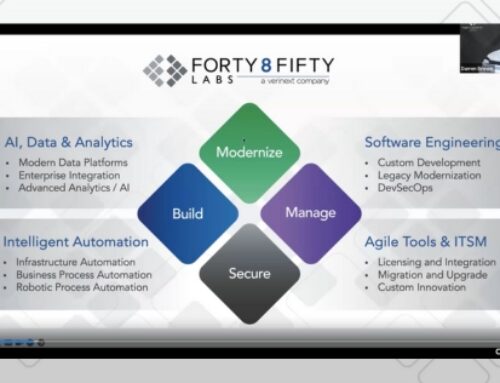[cherry_row]
[cherry_col size_md=”12″]
[mp_code margin=”none,25,none,none”]
During Splunk .conf2017, SiliconANGLE’s The Cube interviewed Atlassian’s Michael Lauricella and Forty8Fifty Labs’ Brooke Gravitt to discuss DevOps trends, customer pain points and how the companies collaborate with Splunk.
From the show floor, The Cube’s Dave Vellante and John Walls asked Lauricella and Gravitt about organizational maturity when it comes to DevOps and the maturity model of automated remediation. They also discuss how Forty8Fifty Labs helps companies embrace the collaborative culture required for DevOps success and the value of the new Real-Time Splunk Connector for Atlassian JIRA Service Desk.
Also discussed was how Atlassian and Forty8Fifty Labs share the vision of helping teams quickly resolve problems faster to keep the customer happy.
“If you look at the value stream mapping and time to market for most businesses, where Splunk and Atlassian play is in getting that fast feedback,” said Gravitt. “The closer in to the development side, or the left side of the value stream, that you can pull in with key metrics, and get an understanding of where issues are, the less expensive it is to fix problems… As a result, you can build more robust enterprise platforms for your teams.”
Watch the full video interview here:
[/mp_code]
[/cherry_col]
[/cherry_row]
[cherry_row type=”full-width” bg_type=”none” bg_position=”center” bg_repeat=”no-repeat” bg_attachment=”scroll” bg_size=”auto” parallax_speed=”1.5″ parallax_invert=”no” min_height=”300″ speed=”1.5″ invert=”no”]
[cherry_col size_md=”3″ class=” motopress-empty mp-hidden-phone”]
[/cherry_col]
[cherry_col size_md=”5″ size_xs=”none” size_sm=”none” size_lg=”none” offset_xs=”none” offset_sm=”none” offset_md=”none” offset_lg=”none” pull_xs=”none” pull_sm=”none” pull_md=”none” pull_lg=”none” push_xs=”none” push_sm=”none” push_md=”none” push_lg=”none” collapse=”no” bg_type=”none” bg_position=”center” bg_repeat=”no-repeat” bg_attachment=”scroll” bg_size=”auto”]
[mp_video src=”https://www.youtube.com/watch?v=R9Q_Y-S3wI8″]
[/cherry_col]
[cherry_col size_md=”4″ class=” motopress-empty mp-hidden-phone”]
[/cherry_col]
[/cherry_row]
[cherry_row type=”full-width” bg_type=”none” bg_position=”center” bg_repeat=”no-repeat” bg_attachment=”scroll” bg_size=”auto” parallax_speed=”1.5″ parallax_invert=”no” min_height=”300″ speed=”1.5″ invert=”no”]
[cherry_col size_md=”12″ size_xs=”none” size_sm=”none” size_lg=”none” offset_xs=”none” offset_sm=”none” offset_md=”none” offset_lg=”none” pull_xs=”none” pull_sm=”none” pull_md=”none” pull_lg=”none” push_xs=”none” push_sm=”none” push_md=”none” push_lg=”none” collapse=”no” bg_type=”none” bg_position=”center” bg_repeat=”no-repeat” bg_attachment=”scroll” bg_size=”auto”]
[mp_text margin=”25,none,none,none”]
To learn more about the Real-Time Splunk Connector for Atlassian JIRA Service Desk, read the press release. It outlines how to automate incident creation in JIRA Service Desk driven by saved Splunk searches in real-time, empowering DevOps teams with the data they can use to resolve incidents fast.
[/mp_text]
[/cherry_col]
[/cherry_row]





